Amplite® Colorimetric Tyrosinase Assay Kit
Amplite® Colorimetric Tyrosinase Assay Kit provides a fast, sensitive method to monitor tyrosinase activity in a range of research and industrial contexts.
- High sensitivity: Detects low levels of tyrosinase activity with strong signal-to-background ratio
- One-step protocol: Simple mix-and-read format minimizes hands-on time and streamlines workflows
- Application versatility: Ideal for melanoma research, tyrosinase inhibitor screening, and pigment pathway analysis
- Comparable alternative: Offers a reliable solution similar to Abcam's tyrosinase activity assay kits


| Catalog | Size | Price | Quantity |
|---|---|---|---|
| 11311 | 100 Tests | Price |
Storage, safety and handling
| Intended use | Research Use Only (RUO) |
Instrument settings
| Absorbance microplate reader | |
| Absorbance | 510 nm |
| Recommended plate | White plate/Clear bottom |
Contact us
| Telephone | |
| Fax | |
| sales@aatbio.com | |
| International | See distributors |
| Bulk request | Inquire |
| Custom size | Inquire |
| Technical Support | Contact us |
| Request quotation | Request |
| Purchase order | Send to sales@aatbio.com |
| Shipping | Standard overnight for United States, inquire for international |
Page updated on November 28, 2025
